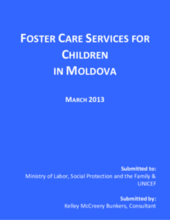This important assessment of foster care services in the Republic of Moldova, conducted for the Government and UNICEF, follows up on the 2012 evaluation of the five-year strategy on care reforms and its findings that despite significant results in the number of children leaving residential care, there were "very few children living in foster care". The very limited use of foster care for children with disabilities and children under the age of three was noted as a particular concern. This assessment provides a comprehensive analysis of the two main types of formal foster care offered in Moldova, the Family Type Children's Homes (CCTF) and the Professional Parental Assistance (APP). CCTF were initiated in the late 1980s as a response to children outside of parental care. This type of care is defined as "an institution created based on a complete family, offering family care in the family of parents-educators, to an orphan child or a child left without parental care." This model was typified by identification and assessment of a couple (with some kind of educational background) to work as "parent- educators" and care for abandoned children on a long-term basis. The homes are usually located in rural areas and each of the families has between four and seven children. The APP, on the other hand, is a relatively new service, piloted since the 2000s and provided a strong basis in law since 2007. Several NGOs were involved in promoting this type of foster care but EveryChild Moldova (P4EC), in particular, has been especially rigorous in supporting the development of a strong policy framework, standards of care and training materials. This type of care situation is similar to foster care utilized in other parts of Europe, whereby a professionally assessed, trained and monitored caregiver provides care, support and protection to a child. In the case of Moldova, a foster caregiver can care for a maximum of three children under this care option. There are different types of foster care options including short-term, long-term, emergency and respite care.
The assessment explores the differences between these two types of foster care, including in terms requirements and profiles of caregivers and of the children, the legal and policy framework underpinning them, including the legal status of the foster parent, as well as the allowances and benefits for each type of care. It finds that differentiation between these different forms of foster care are more a hindrance than a benefit, creating confusion at the community level and also misunderstanding regarding eligibility of children and caregivers. It explores further the barriers to children under 3 and children with disability being placed in each setting and finds that many carers are between 30-50 and work, thus preferring children of school age that do not require full time, stay at home care. This specifically impacts the recruitment of APPs for children with disabilities or children under three. It also underlines that there was unanimous agreement that salaries and allowances should be increased, although particular focus was placed on allowances.
The report provides a range of recommendations in that regard, including for a scale to be developed with caregivers of children with disabilities and/or children under the age of three having the highest salary and increased allowances. It also calls for the development of a new regulation for Professional Parental Assistance Service to gradually bring both the current APP and CCTF services into one unified social service, with different minimum standards, eligibility requirements for caregiver; and child and benefits and allowances depending upon the profile of child in care.
©UNICEF office and the Ministry of Labor, Social Protection and the Family (MoLSPF)

